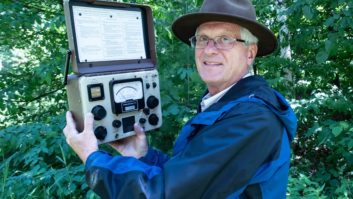Unmanned aerial vehicles — UAVs or “drones” — have been used for years by hobbyists and aircraft enthusiasts, but the field is now seeing rapidly expanding development in commercial applications.
One new use is for the collection of RF signal measurements from broadcast television and radio stations, as is being developed by consulting engineering firm Cavell Mertz & Associates. I will present on this topic at the Broadcast Engineering and Information Technology Conference at the 2017 NAB Show.
TEDIOUS AND COSTLY OPTIONS

The Cavell Mertz UAV platform is a Tarot carbon-fiber frame with six motor arms. The broadband antenna, in blue, is mounted on carbon fiber rods and is counterbalanced by a battery hidden behind the body. The spectrum analyzer, measurement computer and two GPS sensors are atop the flight deck. Kean noted that the red motor mounts indicate the “front” of the craft; however, when measuring, the drone points this side toward the tower and flies “sideways” to maintain proper antenna orientation.
Since the beginning of broadcasting nearly 100 years ago, engineers have sought to measure and verify their antenna systems to answer questions such as “Is my antenna radiating efficiently, especially in the direction of important population centers?” and “Have changes to the tower affected the performance of my antenna?” Unfortunately, the methods to collect signal radiation data from television and radio transmitters have been quite involved.
Field strength measurements, such as those described in Sections 73.314 and 73.686 of the FCC rules, require tedious and expensive measurements, preferably using a receiving antenna at 30 feet above ground. Short mobile runs are taken at numerous, carefully selected locations from which the data is gathered and analyzed.
In the last decade, some engineers have used fixed-wing aircraft or helicopters to gather signal data by flying circles around the tower. While this technique is faster, it can be even more costly. Accuracy is challenging because, at reasonable flight distances, the path geometry may be influenced by ground reflections that are not accountable.
“Drive test” measurements, using a vehicle-mounted antenna, are popular; but owing to the low receiving antenna height, they are strongly affected by terrain and ground clutter, which are almost impossible to remove from the collected data. This makes it hard to identify issues with the antenna system itself.
UAV drones are less costly to operate than manned aircraft and, when flown in proximity to a target tower, often have few FAA restrictions. Nevertheless, they do require consideration of the surrounding environment, weather conditions, consideration of FAA regulations, airspace restrictions and coordination with local airports and helipads. Some operations may require advance FAA approval and waivers. As such, not all planned flights may be possible — advance planning is always necessary. The UAV flight plan should always be prepared and flown by a trained and licensed operator.

Sample polar plot of the signal received by the drone’s RF instrumentation
A TOOL FOR 2017
The Cavell Mertz UAV platform is a Tarot carbon-fiber frame with six motor arms. The brushless motors drive 12-inch props with a combined thrust that can lift a 10,000 mAh lithium battery and instrumentation for extended flights. The flight control computer has inertial sensors to provide a stable flight. The controller receives its flight plan via microwave communications link prior to takeoff, and with its integrated GPS can carry out detailed maneuvers:
• Takeoff and ascent automatically to the assigned elevation
• Undertake a precision orbit around a target antenna
• Manage winds aloft automatically
• Monitor all systems and, if necessary, abort the flight and return to its takeoff site.
More complex flight plans can be specified, for example if another tower is nearby and the UAV must maintain distance from both towers. There is a separate microwave radio link for manual control of the UAV that can be transferred to and from automatic control during flight.
The UAV is capable of ascent and descent over a given point on the ground, so it can collect vertical plane radiation measurements in a relatively precise corridor. This capability can verify that antenna bays are phased properly and that the main antenna beam is formed correctly. On its programmed route, the UAV can fly at a speed of several meters per second, allowing a measurement “orbit” to be completed in a matter of minutes. Testing shows that the UAV can carry out its mission in under 12 minutes, including ascent to most antennas, measurement and descent, with a substantial margin of battery capacity.
PAYLOAD
The instrumentation payload was developed carefully, starting with the antenna. Despite its small size and weight, the biconical antenna spans approximately 30 MHz to 1 GHz, so all VHF and UHF bands can be covered with no tuning or antenna changes. It can be configured for either horizontal or vertical polarization.
The biconical antenna feeds a tiny RF spectrum analyzer weighing less than 8 ounces. The analyzer has a screen and controls, which allows the engineer to check signal conditions and status. Attenuators and filters can be added to handle special conditions. The analyzer performs all digital signal processing, so that work is reduced on the Raspberry Pi computer, also on the payload deck, which stores the measurements and GPS-derived time and location data.
After the flight, a CSV file with the measurements are transferred to a laptop computer, which adjusts for angular speed, distance from the target antenna and re-sampling to a standard 360-degree display, such as the relative field polar chart shown. This type of measurement can be compared to a station’s authorized radiation pattern or the antenna manufacturer’s design specifications.
We believe the new UAV system may be a major advance for antenna testing. As we gain experience with it, it should make antenna performance verification quicker, less expensive and more accurate than previous techniques.
John Kean is a consultant with Cavell Mertz & Associates and a Radio World contributor. He will receive the 2017 NAB Radio Engineering Achievement Award from the National Association of Broadcasters at the NAB Show.
His presentation “Development of an Unmanned Aerial Vehicle for Measurement of Broadcast Antennas” will be held Tuesday afternoon of the convention.



